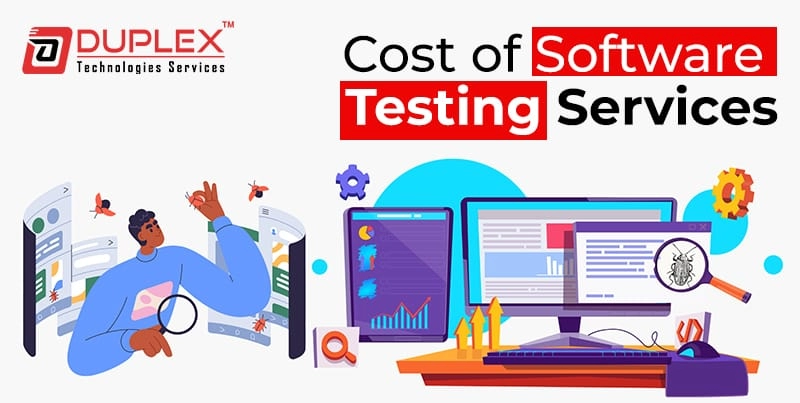Cost of software testing services: Detailed analysis | Factors affecting the software testing costs | Duplex Technologies

Posted By : Ambesh Mishra, Posted Date : Sep 14, 2024
Introduction: cost of software testing services
Let’s learn about the cost of software testing services with Duplex Technologies. We are going to provide you some of the useful information about the software testing costs and the factors influencing them.
When compared to the significance of software in current functioning, testing is necessarily vital for fluid business practices. Business processes rely on the use of software applications, and when these applications fail, organizations will suffer huge losses. Testing is a way of reducing risks by guaranteeing reliability, security, and performance levels. As with any type of service, software testing services’ price also varies with such factors as project complexity, the scope of testing, and the kind of technology needed. It was identified that the software testing pricing can be an average of 10% – 30% of the overall cost of frame-developed software. However, it is an investment worth making since it avoids costly mistakes, delays in maintenance, and increases efficiency.
Table of Contents
Types of software testing | software testing costs
There are various types of software testing procedures such as:
Manual Testing: In this testing, the testing team relies on people to run a script and look for issues in the application. For this reason, the approach is time-consuming and rather labor-intensive, although it offers extensive information. Based on the given requirements, the testers can work on an unplanned condition and get to know more about the bound limits.
Automated Testing: Automated testing employs the use of tools to run tests that were developed in advance, thus minimizing the need for hand operations. Automation thus increases rate, improves accuracy, and allows for repeat of tests. One of the benefits is that tools can run the tests simultaneously; hence, they are faster. Thus, automation software testing costs are higher in the beginning and in terms of tooling and its maintenance.
Security Testing: Security testing is done to ensure the software's integrity since it has vulnerabilities tested. This kind of testing helps to defend against cyber risks and losses from data theft. Security testing encompasses penetration testing, vulnerability testing, and audits for compliance.
Performance Testing: Performance testing assesses the application's behavior when submitted to different loads. This type of testing helps make assurance of the software scalability, reliability, and response time. There are three key types of performance testing, namely load testing, stress testing, and endurance testing. That it has to be done by specialized tools and methods.
Usability Testing: Usability testing is used to assess software usability as well as the experience the user is likely to get while using the software. Usability testing of this nature focuses on ascertaining if a software program is easy to use, easily navigable, and friendly to users.
Compatibility Testing: Compatibility testing will check that the software is functional throughout various surroundings and platforms. Examples of this type of testing include cross-browser testing, cross-operating systems, and cross-device testing. Compatibility testing makes sure that a piece of software works as well on another type of platform. It calls for the use of several devices as well as different conditions for experimentation.
Elements determining the cost of software testing services
There are various attributes that determine the cost of software testing services:
Project Complexity
The software testing costs are directly proportional to the project’s complexity since complicated applications entail elaborate testing. The complicated projects are those, that consist of several integrations, the functions of which are critical, and the interactions which are not simple. This requires more time on testing, qualified personnel, and sophisticated equipment, adding to the cost.
Technology Requirements
The use of specific technology may necessitate the use of special equipment and software, which increases the cost of software testing services. These requirements may call for other tools, licenses, or manpower; this creates more cost. However, due to the constraints in technology, there can be a compromise in testing effectiveness and this may slow testing time and be expensive. Such a need may greatly influence testing budgets due to the requirement of the newest technologies.
Testing Methodologies
Test approaches such as Agile, Waterfall, and Hybrid determine the length of testing and also determine the software testing pricing as they also have to run on constant testing, which can be ultimately expensive under the Agile methodologies. A potential drawback of waterfall approaches is more elaborate testing at the end, which can and will affect costs. These factors come in different models that have hybrid balances, and depending on the aspect, it will impact costs.
Time Constraints
When the testing schedule is particularly tight, the testing team usually has to pay extra to get the overtime or extra resources, or introduce the testing hurry. Contrary to that, time restrictions may require a larger number of testers, specialized tools or working for longer hours, which again increases the software testing costs. Other problems include difficulty in producing valid results within the shortest time possible and rushed testing can sometimes yield wrong results that lead to retesting, hence adding to the cost.
Test Environment and Infrastructure
Test environments, hardware and software often come with a cost implication when setting up as well as when running tests. Original systems and systems under testing must mimic production and therefore incur a lot of costs. Also, cost can be created by upgrades or maintenance to the hardware and software of the business firm. Unfortunately, maintaining a fairly stable test environment is not an inexpensive endeavor, although it is a significant one.
Security and Compliance
The cost of software testing services can be bumped up depending on testing specific areas of security or compliance requirements, like HIPAA or PCI-DSS. These requirements call for a specialist’s attention, equipment, as well as procedures that are costly. Compliance testing is effective and necessary in order to avoid nonconformities and fines, but the task entails substantial costs.
Analyzing the cost structure | software testing pricing
Direct cost elements are labor, tools and software, infrastructure, project management, test environment, test data management, training & certification, travel and accommodation, and others. These costs include factors such as project type, extent of testing, adoption of new technology, time, geographical location, and personnel. These components blend to define the total software testing pricing. Let’s analyze the cost structure in more detail.
To optimize the controlling of cost of software testing services, it is important for an analyst to get to learn their cost structure and how different cost components affect the total cost. This knowledge enables you to:
Optimize Resource Allocation: Provide objectives that would ensure effective use of resources so that resources are not wasted and the cost is lowered.
Negotiate with Service Providers: With knowledge and information, testing service providers can be convinced to offer better rates and agreeable terms.
Make informed decisions: Understand the costs associated with various testing strategies, methodologies, tools, and technologies.
Set Realistic Budgets: Set realistic budget safeguards because of excessive or insufficient spending to complete testing.
Understanding the distribution of software testing costs helps a person to meet his/her goals in respect of effective management of resources and costs.
Techniques to reduce the software testing costs
Test Automation
It is the practice of using scripts rather than human efforts in testing processes. This makes it possible to reduce testing time and software testing costs while at the same improving the degree of accuracy. When running the automation, results can be obtained again and again with no deviations from previous results. With this, it is easier to conduct tests and bring to market products within a short time.
Test Environment Optimization
Optimization is only in a testing environment where efficiencies in the use of test infrastructure and resources are worked on. This includes sharing of resources, use of cloud-based infrastructures and minimizing the amount of time taken to set up test environments. Optimized testing environments result in the overall reduction of software testing pricing, enhanced effectiveness in testing while also improving the overall quality of the test.
Crowdsourced Testing
Crowdsourced testing uses testers from around the world to ensure different testing points of view. This approach reveals the problems that internal teams can not discover. This method saves the cost of software testing services, increases testing coverage, and gives the possibility to receive the results in the shortest time. It is especially suitable where the application impacted user types are different.
Test Data Management
Test data management means that the test data will be reused and mask so that there are only more costs for data creation and maintenance. This makes data consistent, reduces duplication of data, and also enhances the efficiency of testing. Management of testing data accelerates the speed of testing, optimizes the software testing pricing and increases the level of test precision.
Continuous Testing
Automated testing in the process of continuous testing is implemented as part of the development process, so testing takes less time and money. It makes it easier to identify the defects, which translates to faster testing and increases the quality of the software produced.
Offshore Testing
Offshore testing takes advantage of affordable testing centers that are located outside the testing team’s location. This approach cuts down on the expenses of testing, thereby increasing the ability to conduct tests and get feedback in a shorter duration. Offshore testing can be carried out together with testing service providers, especially in countries with cheaper human resource costs.
Risk-Based Testing
Risk-based testing aims to identify and test so-called risky areas, which in turn leads to a decreased overall level of cost of software testing services. This approach targets the testing activities by targeting the key functionalities and risky areas. Risk-based testing helps to focus testing efforts on business risks, thus minimizing costs spent in testing and increasing efficiency in testing. That’s why it is appropriate for projects with restricted testing time available.
Conclusion
The cost of software testing services is also influenced by some factors, such as the type and size of the project, the extent of testing, and the level of specialization. The details of such factors and approaches to cost optimization will enable the minimization of software testing pricing. Strategies such as test automation, crowdsourced testing, and offshore testing can help the organization cut down on its costs without necessarily suggesting any compromise on quality. Risk-based testing therefore helps testing efforts to be aligned with business objectives. In the following aspects, selecting the right testing approach and using more automation and appropriate testing environments can help organizations obtain considerable software testing cost reduction while developing more reliable and high-quality software products. Therefore, a specific approach to the management of software testing can significantly reduce expenditures and enhance the efficiency of the process. Thus, testing is an essential part of developing software.




















































































